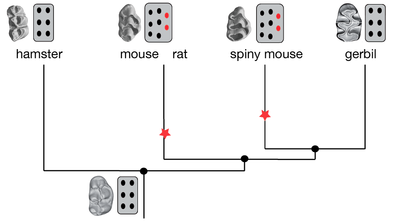Does the evolution of development mirror the evolution of morphologies?
We use the rodent first molar and our favourite tool: the comparison of transcriptomic timeseries to compare cellular and molecular developmental processes underpinning the final morphology.
- Does conservation/divergence in development follow that of morphologies?
Dental plans (number and arrangement of cusps) can remain relatively conserved over long evolutionary periods or be profoundly transformed over short periods. This is the case of the mouse upper molar, that evolved a third cusp row less than 18 MYA. In contrast, the mouse lower molar retained the same number of cusps, as did lower and upper molars of golden hamster. By tracking whole genome expression in transcriptome timeseries, combined with fine-resolution description of morphogenesis and patterning, we compare the development of first lower and upper molars in these two species, asking whether the divergence in developmental system matches the divergence in morphology. See our surprising result in our latest preprint here.
|
A case of convergence in tooth morphology:
|
- Does convergent evolution imply convergent development?
There are few examples in the literature documenting the mechanisms underlying the repeated acquisition of a complex morphology. One such case is the independent evolution of the murine dental plan in mouse and Acomys lineages, where two supplementary cusps develop lingually at the surface of the molar crown (see also here). Again, by tracking whole genome expression in transcriptome timeseries, combined with fine-resolution description of morphogenesis and patterning, we compare the development of molars in these two species and two control species (hamster and gerbil), asking whether development is convergent, and at which level (gene, pathway, process?).
People involved in the team:
Present: Timothée Katylevsky, Claudine Corneloup
Past: Jeremy Ganovsky, Coraline Petit; Carine Rey; Marion Mouginot,Anne Lambert, Manon Peltier, Alain Rubod, Mathilde Estevez-Villar
Collaborations: Laurent Guéguen, Université Lyon 1

 mice and spiny mice acquired independently 2 additional cusps at their upper molar
mice and spiny mice acquired independently 2 additional cusps at their upper molar